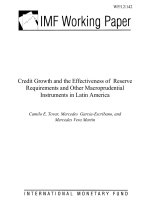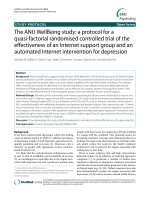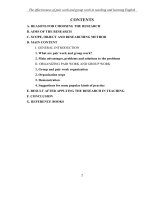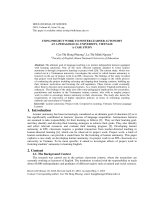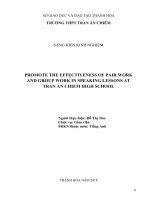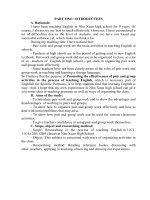SKKN the effectiveness of pair work and group work in teaching and learning english
Bạn đang xem bản rút gọn của tài liệu. Xem và tải ngay bản đầy đủ của tài liệu tại đây (199.59 KB, 19 trang )
SỞ GIÁO DỤC ĐÀO TẠO ĐỒNG NAI
Trường THPT Nguyễn Hữu Cảnh
Mã số :…………
THE EFFECTIVENESS OF
PAIR WORK AND GROUP WORK
IN TEACHING
AND LEARNING ENGLISH
Người thực hiện: Nguyễn Thị Xuân Mai
Lĩnh vực nghiên cứu:
Quản lý giáo dục:
Phương pháp dạy học bộ môn:
Phương pháp giáo dục:
Lĩnh vực khác: ………………
Có đính kèm:
Mô hình Phần mềm
Phim ảnh
Hiện vật khác
The effectiveness of pair work and group work in teaching and learning English
CONTENTS
A. REASONS FOR CHOOSING THE RESEARCH
B. AIMS OF THE RESEARCH
C. SCOPE, OBJECT AND RESEARCHING METHOD
D. MAIN CONTENT
I. GENERAL INTRODUCTION
1. What are pair work and group work?
2. Main advantages, problems and solutions to the problems
II. ORGANIZING PAIR WORK AND GROUP WORK
1. Group and pair work organization
2. Organization steps
3. Demonstration
4. Suggestions for some popular kinds of practice
E. RESULT AFTER APPLYING THE RESEARCH IN TEACHING
F. CONCLUSION
G. REFERENCE BOOKS
2
The effectiveness of pair work and group work in teaching and learning English
A. REASONS FOR CHOOSING THE RESEARCH
This is the sixth year we are carrying out the reformation in teaching new
English textbook. Most of the teachers are used to this new English textbook and
try to find out good teaching methods as much as possible to apply in English
periods.
In order to make his English period more effective, the teacher himself must find
out the way of teaching suitable for his students. I think that in a good English
period, the students play active roles and the teacher is only the adviser.
All the teachers know pair work and group work are the main activities in
teaching English at schools. There is always pair work or group work in each
lesson of textbook but at times it is not suitable for some classes. If the teacher
wants his students to play active roles, he should design pair work and group work
before going to class for each period. But sometimes the teacher gets stuck in
organizing pair work and group work effectively.
I myself want to present how I apply pair work and group work in most of my
teaching English periods.
B. AIMS OF THE RESEARCH
- To introduce pair work and group work and to show the advantages of
working in pairs and groups.
- To show how to organize pair and group work effectively and how to deal
with initial problems that may arise.
- To show how pair and group work can be used for various classroom
activities.
- To give teachers confidence in using pair and group work themselves.
C. SCOPE, OBJECT AND RESEARCHING METHOD
- Scope: Researching in the process of teaching English at Nguyen Huu
Canh high school.
- Object: Being concerned with ways of organizing activities in the class.
- Researching method: Reading reference books, discussing with other
teachers,
3
The effectiveness of pair work and group work in teaching and learning English
applying in teaching, observing and drawing out experiences.
D. CONTENT
I. GENERAL INTRODUCTION
1. What are pair work and group work?
1.1. Pair work:
The teacher divides the whole class into pairs. Every student works with his
or her partner and all the pairs work at the same time. The teacher walks around,
listens and intervenes little if necessary.
1.2 Group work:
Students work in small groups (of four or five) on tasks that entail
interaction: conveying information, for example, or group decision making. All the
groups work at the same time. The teacher walks around, listens, and intervenes
little if necessary.
2. Main advantages, problems and solutions to the problems
For certain types of activities, pair work and group work have any number of
advantages in working with the whole class together. Teachers should think what
the main advantages are, and also what problems might be involved in pair work,
group work and the solutions for these.
Here are some main advantages and problems:
Advantages
Problems
- Students have more chances to practise - The class is noisy.
English.
- Students make mistakes.
- Students are more involved.
- It is sometimes difficult to control
- Students feel more confident.
class.
- Students learn from each other.
……
- Students know how to co-operate and
share the work with each other.
- Teacher can save time.
……
4
The effectiveness of pair work and group work in teaching and learning English
(Of course, your own advantages and problems may look slightly different from
these, but most teachers’ suggestions will probably fit under these headings)
Now, we will discuss each heading in more detail. First, let’s start with the
advantages.
* Students have more chances to practise English:
Pair work and group work give students far more chance to speak English.
For example, students are given an exercise of making sentences (question &
answer), working in pairs, each student makes as many sentences as they can. If
the exercise was done “round the class”, every student can have a chance to say at
least one sentence.
* Students are more involved:
Some activities will probably be dominated by a few students and others
may lose interest if they are conducted with the whole class together. Working in
pairs or groups encourages students to be more involved and to concentrate on the
task.
* Students feel more confident:
Students feel less anxious when they are working in pairs or groups than
when they are on show in front of the whole class. Pair work and group work can
help shy students who never say anything in a whole class activity.
* Students learn from each other:
Pair work and group work encourage students to share ideas and
knowledge. In a reading activity, students can help each other to explore the
meaning of a text; in a discussion activity, students can give each other new ideas.
* Students know how to co-operate and share the work with each other:
5
The effectiveness of pair work and group work in teaching and learning English
Students know that their task is successful or not it depends on not only
themselves but also their partners. Therefore, when working in pairs or groups
students know how to co-operate and share the work with each other to lead a good
result.
* Teacher can save time:
When teacher asks students work in pairs or groups at the same time he can
save more time than when he gets them to work individually.
Now talk about the problems, and discuss the ways of recovering them:
* The class is noisy:
Obviously pair work and group work in a large class will be noisy, and this
cannot be helped. But:
- Usually the students themselves are not disturbed by the noise; it is more
noticeable to the teacher standing at the side or to someone in the next room.
- The noise created by pair work and group work is usually “good” noise.
Students use English or engage in a learning task. Teacher should stop the activity
when most groups or pairs have finished or prepare a “reserve” task to occupy
members of groups who finish earlier than expected.
* Students make mistakes:
During a pair or group activity, the teacher cannot control all the language
used, and should not try to do so. When doing controlled language practised in
pairs or groups, the number of mistakes can be reduced by:
- Giving enough preparation, the activity can be done with some model
presentation first, and pair work or group work is used in final stage.
- Checking afterwards, the teacher can ask some pairs or groups what they
said, and then correct mistakes if necessary.
6
The effectiveness of pair work and group work in teaching and learning English
* It is sometimes difficult to control class:
The teacher has less control over what students are doing in pair work and
group work than in normal class. To stop activities getting out of control, it is
important to:
- Give clear instructions on how to start, what to do and when to stop.
- Give clearly defined tasks which don’t continue for too long.
- Set up a routine, so that students accept the idea of working in pairs or
groups, and know exactly what to do.
II. ORGANIZING PAIR WORK AND GROUP WORK
1. Group and pair work organization
- The success of group or pair work depends on some extents:
The climate of the class
The students’ habit of working in pairs or groups
The selection of an interesting and stimulating task of the teacher
The good performance within the ability of the group or pair
- More immediately, it also depends on:
Effective and careful organization
2. Organization steps:
2.1. Presentation:
The instructions that are given at the beginning are crucial. If the students do
not understand exactly what they have to do, there will be a waste of time,
confusion, lack of effective practice, possible loss of control. Select tasks that are
simple enough to describe easily; and in monolingual classes, you may find it costeffective to explain some or all in the students’ mother tongue. It is advisable to
give the instructions before giving out materials and dividing the class into pairs or
groups; and a preliminary rehearsal or “dry run” of a sample of the activity with
the full class can help to clarify things. If your students have already done similar
activities, you will be able to shorten the process, giving only brief guidelines; It is
7
The effectiveness of pair work and group work in teaching and learning English
mainly the first time of doing something with a class that such care needs to be
invested in instructing.
Try to foresee what language will be needed, and have a preliminary quick
review of appropriate grammar or vocabulary. Finally before giving the sign to
start tell the class what the arrangements are for stopping: If there is a time limit, or
a set signal for stopping, say what it is; if the pairs or groups simply stop when
they have finished, then tell them what they will have to do next. It is wise to have
a reserve task planned to occupy members of pairs or groups who finish earlier
than expected.
2.2. Process:
Teacher goes from group to group, pair to pair, monitor, and either
contribute or keep out of the way whichever is likely to be more helpful. If you do
decide to intervene, your contribution may take the form of:
- Providing general approval and support;
- Helping students who are having difficultly;
- Keeping the students using the target language (in many cases your mere
presence will ensure this!)
- Tactfully regulating participation in a discussion where you find some
students are over dominant and others are silent.
2.3. Ending:
Draw the activity to a close at a certain point. Try to finish the activity while
the students are still enjoying it and interested, or only just beginning to flag.
2.4. Feedback:
A feedback session usually takes place in the context of full-class interaction
after the end of the pair work or group work. Feedback on the tasks may take many
forms:
- Giving the right solution, if there is one
- Listening to and evaluating suggestions
- Pooling ideas on the board
8
The effectiveness of pair work and group work in teaching and learning English
- Displaying the materials the groups/ pairs have produced
And so on
The main objective here is to express appreciation of the effort that has been
invested and its results. Feedback on language may be integrated into this
discussion of the task, or provide the focus of a separate class session later.
3. Demonstration:
Before teaching teacher should prepare pair work and group work activities
carefully. If he can do so the students are attracted to his designed activities. The
climate of the class is very exciting as everyone must practise.
Some teachers say that pair work and group work can only be applied in speaking
or reading periods. For me I can apply them in all periods. Besides teacher can
redesign the material so that it is suitable for his students. And below are some my
examples that I have already applied.
3.1. Examples of pair work:
Example 1:
In Unit 1: Friendship – Reading (English 11)
Teacher: Practise these questions in pairs (Warm-up)
1. Do you have a best friend?
2. Why do you consider him / her as your best friend?
The theme of this unit is very familiar with the students. They practise in pairs very
frankly and openly.
Example 2:
In Unit 8: Celebrations – Speaking (English 11)
Teacher: Practice reading the dialogue in pairs.
Mai: Do you know that Tet holiday is next month?
Model: Mai is talking with Anna, her new English friend, about Tet holiday in
1
Vietnam.
Anna: What is Tet?
Mai: It’s the time when Vietnamese people celebrate the beginning of spring. It’s
also the start of the lunar new year.
2
Anna: When is it exactly?
Mai: Well, this year it’s on the 9th of February.
3
Anna: What do people usually do at Tet?
Mai: Well, they eat a lot of special foods,
9 they dress up and visit friends and
relatives, and they also play some traditional games.
4
Anna: Oh, that sounds really interesting.
The effectiveness of pair work and group work in teaching and learning English
After students practise this dialogue fluently I ask them to replace the underlined
words by:
1
Thanksgiving
2
People celebrate
3
third Thursday in
4
Family members get
the harvest.
November
together. They prepare a
large meal with roast
Valentine’s Day People express
turkey.
They give chocolates,
th
14 February
their love to each
flowers or gifts to the
Mid-Autumn
other.
People celebrate
15 day of the 8
Festival
the largest full
lunar month
th
th
moon in the year.
people they love.
Children wear masks,
parade in the street, have
parties with special cakes
and lots of fruits, etc.
This practice helps every student in class and no one gets stuck.
Example 3:
In Unit 7: World Population – Language Focus (English 11)
Teacher: Practise asking and answering, using conditional sentences in pairs.
(After the students study grammar)
Model:
A: What will you do if you pass the final exam?
B: If I pass the final exam I will try to find a good job.
10
The effectiveness of pair work and group work in teaching and learning English
A: What would you do if you were a millionaire?
B: If I were a millionaire I would travel around the world.
A: What would you have done if you hadn’t had enough money to pay for the
meal last night?
B: If I hadn’t had enough money to pay for the meal last night I would have asked
you some.
Students look at the model and it is easy for them to practise in pairs.
Example 4:
In Unit 4: School Education System – Writing (English 12)
Teacher: Work in pairs. Ask and answer these questions as quickly as possible.
(Before you write)
1. At what age does a child start school in Vietnam?
2. How many terms are there in a school year?
3. When does a school year generally begin and end?
4. How long does it take to complete primary education?
5. How many grades are there in Vietnamese lower secondary school?
6. How many grades are there in Vietnamese upper secondary school?
7. Is upper secondary education compulsory?
If students work in pairs carefully to answer these questions they will find it easy
to write about the school education system in Vietnam.
3.2. Examples of group work:
Example 1:
In Unit 3: A party – Speaking (English 11)
Teacher: Work in groups. You are going to take part in a competition to organize
the best party. Decide on the following:
- budget
- formal or informal dress
- date and time
- decorations
- who to invite
- entertainment (music, games, etc.)
11
The effectiveness of pair work and group work in teaching and learning English
- place
- food and drink
When students work in groups they should co-operate and share the work with
each other. If they know how to work together and help each other their group will
finish earlier.
Example 2:
In Unit 1: Home life – Speaking (English 12)
Teacher: Work in groups of four (the father, the mother, the daughter, the son).
Each person in the family says something about the family and duties to the
family.
Students work in groups and they find it easy to finish their roles.
Example 3:
In Unit 7: World Population – Listening (English 11)
Teacher: Close your textbooks. Work in groups to finish the chart. (After you
listen)
I want to check their understanding about the content of the passage that they have
already listened to.
(1) shortage of food
(2) lack of hospitals and schools
problems
(3) illiteracy
(4) low living standards
(1) to educate people and make them
aware of the danger of having more
children
Population
Explosion
solutions
12
(2) to provide safe, inexpensive birthcontrol methods
The effectiveness of pair work and group work in teaching and learning English
(3) to strictly implement a family
planning policy
(4) to exercise strict and fair reward
and punishment policies
Students work in groups and finish this task more quickly than do it individually.
Example 3:
In Unit 2: Cultural Diversity – Reading (English 12)
Teacher: Work in groups to discuss the question: “What are the differences
between a traditional Vietnamese family and a modern Vietnamese family?”
Students discuss in groups to find out the differences as many as possible.
The features of a traditional Vietnamese
The features of a modern Vietnamese
family
family
- There are a lot of children in the family.
- There are only one or two children in
- Parents often decide who the children
the family.
will marry.
- Parents let their children decide whom
- Wives never decide to do things in the
they will marry.
family without asking their husbands’
- Both the father and the mother work to
opinions. Most men often achieve a
earn the living.
dominant position in the family. The
- The mother takes care of the
father is the head of the household who
housework and the children with the
presents authority and makes all the
help of the father.
important decisions. His wife is
- The father can look after his children
responsible for the domestic side of
and help in the house even his wife
family life.
doesn’t go out to work.
- Men rarely cook in the kitchen. Cooking …………
is considered women’s task.
13
The effectiveness of pair work and group work in teaching and learning English
…………
Example 4:
In Unit 3: A party – Writing (English 11)
Teacher: Work in groups. Read the instructions carefully and cross out the words
in the table. When you have followed all the instructions, there will be five words
left. What are the five words? How are they connected? (Warm up)
A
B
C
D
1
overcoat
referee
flower
2
exercise
lecture
tablet
essay
3
duck
champion candles
parrot
4
gift
wardrobe
coach
operation
card
golf
cartoon
drama
photos
injection
floods
perform
5
6
earthquake
14
1. Cross out four words
connected with sports from
B.
2. Cross out three words
connected with education
from 2.
3. Cross out three words
connected with medicine
and illness from C.
4. Cross out two birds
from 3.
5. Cross out three words
connected with the theatre
from 5.
The effectiveness of pair work and group work in teaching and learning English
6. Cross out two words
connected with clothing
from 1.
7. Cross out two words
connected with the
natural world from 6.
Students work in groups and find out five words left quickly: flower, candles, gift,
card, photos. They are connected with a party.
From my examples above you can see I can almost apply pair work and
group work in most of my teaching periods.
4. Suggestions for some popular kinds of practice
Pair work and group work are not “teaching methods”, but ways of
organizing the class. They can be used for many different kinds of activity, and are
naturally more suitable for some activities than for others. Before deciding what
kind of activity will be used teacher should answer the following questions:
- Can you use pair work or group work for part of the activity?
- If so, exactly what will students do in pairs or groups?
- What will you need to do before the pair /group stage?
- Is there anything you will do after it?
Here are suggestions for some popular kinds of practice:
*Pattern practice:
This can be done in pairs in the same way as practising conditional
sentences mentioned in example 3 (Example of pair work – Demonstration). Any
controlled oral practice can be done first with the whole class, and then in pairs.
* Practising short dialogues:
15
The effectiveness of pair work and group work in teaching and learning English
Acting out short dialogues can very easily be done in pairs, with little chance of
making mistakes. It can be done first with pairs of students in front of the class
and then with all students working in pairs at the same time.
* Reading a text and answering questions:
Students can discuss questions in pairs or groups and then read the text or
they can read the text silently and then ask and answer questions in pairs or groups.
This is a good way of involving the whole class in answering questions.
* Short-writing exercises:
Students can sit in groups and decide together what to write. In each group,
one student acts as “group leader”, one student acts as “secretary”. This can be
difficult to organise but in a large class it has the advantages that students correct
each others’ mistakes and the teacher only has a few papers to mark in the end.
Pair work can be used for correcting written work (eg: homework). Students
sit in pairs and correct what their partners have written.
* Discussions:
With more advanced class, discussions can be conducted in groups. It is
important to define the discussion clearly and to ask each group to report their
conclusions afterwards.
* Grammar exercises:
Students can do grammar exercises orally in pairs; the teacher goes through
the answers afterwards with the whole class and students write the exercises for
homework. This is more interesting and productive than students doing exercises
alone, in silence.
E. RESULT AFTER APPLYING THE RESEARCH IN TEACHING
The table below expresses clearly the differences in the students’ attitude
towards the way to participate in the lessons. Before applying the research in
teaching not all students in classes take part in the lessons actively. After applying
it,
students join in the lessons more actively. The climate of classes is more exciting.
Class
Number of Before applying the research After applying the research in
16
The effectiveness of pair work and group work in teaching and learning English
students
in teaching
teaching
12A3
43
about 35% of students take about 73% of students take
12A6
11A7
11A9
45
part actively in the lessons
part actively in the lessons
about 38% of students take about 77% of students take
44
part actively in the lessons
part actively in the lessons
about 52% of students take about 83% of students take
45
part actively in the lessons
part actively in the lessons
about 59% of students take about 93% of students take
part actively in the lessons
part actively in the lessons
F. CONCLUSION:
In group or pair work, learners from a learning task can play active roles
through small pair or group interaction. Learners in a class that is divided into
eight groups or 20 pairs get eight times or twenty times as many opportunities to
communicate as in full class organization. The effectiveness of pair work and
group work is that it fosters learners responsibility and independence, it can
improve motivation and contribute to a feeling of cooperation and warmth in the
class, so that organizing pair work and group work effectively helps improve
learning outcomes.
Despite my trying a lot, the content of this research is only my personal
experience of teaching. Therefore, there must be some mistakes that I myself still
cannot find out. I hope I will get suggestions from the readers as many as possible.
I hope that the study will make contribution to the better situation of
teaching and learning English.
Thank you very much
Bien Hoa city, May 22nd 2012
Composer
Nguyen Thi Xuan Mai
17
The effectiveness of pair work and group work in teaching and learning English
REFERENCE BOOKS
1. Practical handbook of language teaching (David Cross)
2. A course in language teaching - Practical and Theory (Penny Ur) Cambrige
university press
3. Giáo trình giáo học pháp (Tổ ngoại ngữ –Khoa ngôn ngữ và văn hóa Anh - Mĩ Úc – Trường đại học quốc gia Hà Nội)
4. Phương pháp dạy tiếng Anh Trung học phổ thông (Nguyễn Hạnh Dung)
18
The effectiveness of pair work and group work in teaching and learning English
SỞ GD & ĐT ĐỒNG NAI
Trường THPT Nguyễn Hữu Cảnh
CỘNG HOÀ XÃ HỘI CHỦ NGHĨA VIỆT NAM
Độc lập – Tự do – Hạnh phúc
Biên Hoà, ngày 22 tháng 5 năm 2012
PHIẾU NHẬN XÉT, ĐÁNH GIÁ SÁNG KIẾN KINH NGHIỆM
Năm học: 2011 - 2012
Tên sáng kiến kinh nghiệm:
The effectiveness of pair work and group work in teaching and learning English
Họ và tên tác giả: Nguyễn Thị Xuân Mai
Đơn vị (tổ): Tổ Ngoại Ngữ
Lĩnh vực:
Quản lý giáo dục
Phương pháp dạy học bộ môn
Phương pháp giáo dục
Lĩnh vực khác ………………………….
1. Tính mới:
- Có giải pháp hoàn toàn mới.
- Có giải pháp cải tiến đổi mới từ giải pháp đã có.
2. Hiệu quả:
- Hoàn toàn mới và đã triển khai áp dụng trong toàn ngành có hiệu quả cao.
- Có tính cải tiến hoặc đổi mới từ những giải pháp đã có và đã triển khai áp dụng
trong toàn ngành có hiệu quả cao.
- Hoàn toàn mới và đã triển khai áp dụng tại đơn vị có hiệu quả cao.
- Có tính cải tiến hoặc đổi mới và đã triển khai áp dụng tại đơn vị có hiệu quả.
3. Khả năng áp dụng:
- Cung cấp được các luận cứ khoa học cho việc hoạch định đường lối chính sách:
Tốt
Khá
Đạt
- Đưa ra các giải pháp khuyến nghị có khả năng ứng dụng thực tiễn, dễ thực hiện
và dễ đi vào cuộc sống:
Tốt
Khá
Đạt
- Đã được áp dụng vào thực tế đạt hiệu quả hoặc có khả năng áp dụng đạt hiệu quả
trong phạm rộng:
Tốt
Khá
Đạt
XÁC NHẬN CỦA TỔ CHUYÊN MÔN
Tổ trưởng
Lý Thị Thanh Tâm
HIỆU TRƯỞNG
Phan Quang Vinh
19
